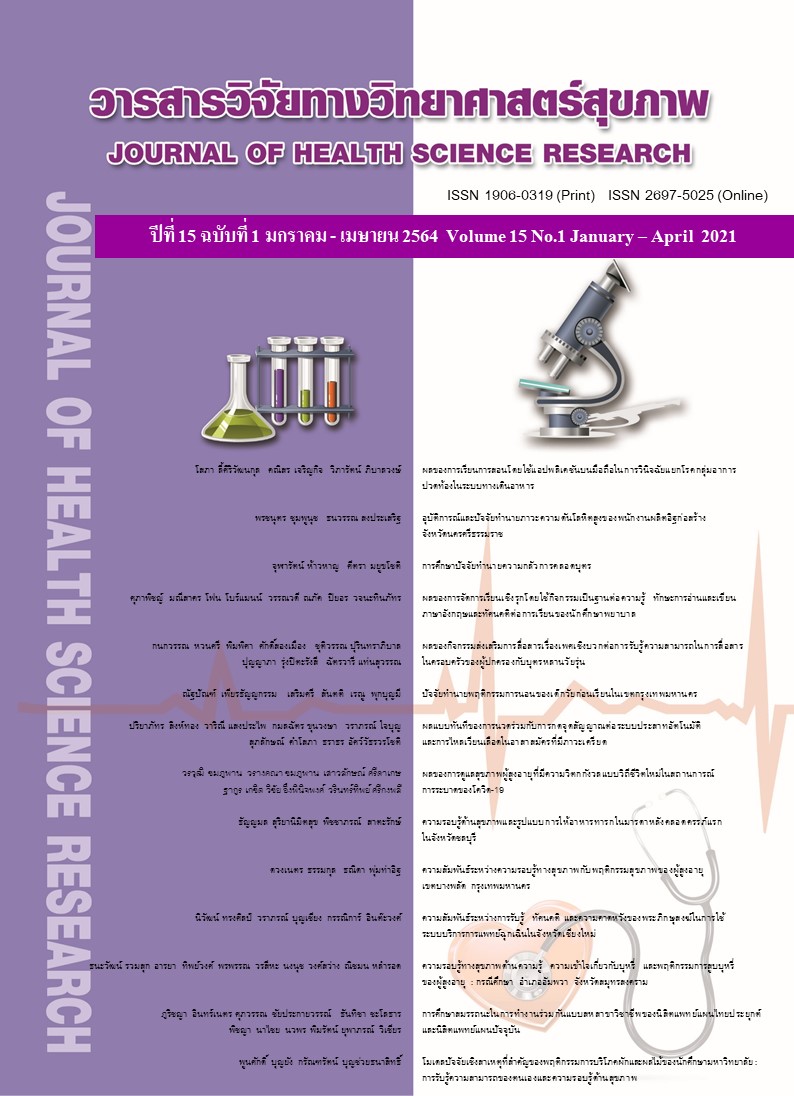A การศึกษาปัจจัยทำนายความกลัวการคลอดบุตร
Main Article Content
บทคัดย่อ
บทนำ : ความเข้าใจความกลัวการคลอดบุตร ทำให้มีการวางแผนการพยาบาลที่ช่วยหญิงระยะคลอดให้มีการเผชิญกับความกลัวอย่างเหมาะสม และมีประสบการณ์การคลอดที่ดี
วัตถุประสงค์การวิจัย : เพื่อศึกษาความสัมพันธ์ระหว่างปัจจัยบางประการกับความกลัวการคลอดบุตร และปัจจัยทำนายความกลัวการคลอดบุตร
วิธีการวิจัย : การศึกษาเชิงความสัมพันธ์ ตัวอย่าง มีอายุครรภ์ตั้งแต่ 28 สัปดาห์ขึ้นไป และไม่มีภาวะแทรกซ้อน จำนวน 123 คน เลือกแบบเจาะจงจากผู้คลอดที่โรงพยาบาลแห่งหนึ่ง เครื่องมือวิจัยประกอบด้วย แบบสอบถามการคาดการณ์/ประสบการณ์การคลอดบุตรของวิจมา แบบ B และแบบประเมินความกลัวการคลอดบุตรในระยะคลอด มีค่าสัมประสิทธิ์แอลฟาของครอนบาค เท่ากับ .88 และ .70 ตามลำดับ วิเคราะห์ความสัมพันธ์ของปัจจัยบางประการกับความกลัวการคลอดบุตร โดยใช้สถิติสหสัมพันธ์ของเพียร์สัน และปัจจัยทำนายความกลัวการคลอดบุตรใช้การวิเคราะห์การถดถอยพหุคูณ
ผลการวิจัย : พบว่า ความกลัวการคลอดบุตรมีความสัมพันธ์ทางลบกับอายุอย่างมีนัยสำคัญทางสถิติ (p<.05) ความกลัวการคลอดบุตรมีความสัมพันธ์ทางบวกกับความกลัวระยะคลอดอย่างมีนัยสำคัญทางสถิติ (p<.001) ความกลัวระยะคลอดร่วมกับอายุสามารถทำนายความกลัวการคลอดบุตรได้ ร้อยละ 31.10 (R2 =.311, F = 8.73, p<.001) ดังสมการ ความกลัวการคลอดบุตร = 104.38 + .70 (ความกลัวการคลอดบุตรในระยะคลอด) - .82 (อายุ)
สรุปผล : หญิงในระยะคลอดมีความกลัวการคลอดบุตรในระยะคลอดสูงและมีอายุน้อยจะมีความกลัวการคลอดบุตรสูง ดังนั้น พยาบาลต้องวางแผนการพยาบาลในการประเมินความกลัวการคลอดที่คำนึงถึงอายุของผู้คลอด
Downloads
Article Details
บทความที่ได้รับการตีพิมพ์เป็นลิขสิทธิ์ของวิทยาลัยพยาบาลบรมราชชนนี จังหวัดนนทบุรี
ข้อความที่ปรากฏในบทความแต่ละเรื่องในวารสารวิชาการเล่มนี้เป็นความคิดเห็นส่วนตัวของผู้เขียนแต่ละท่านไม่เกี่ยวข้องกับวิทยาลัยพยาบาลบรมราชชนนี จังหวัดนนทบุรี และคณาจารย์ท่านอื่น ในวิทยาลัยฯ แต่อย่างใด ความรับผิดชอบองค์ประกอบทั้งหมดของบทความแต่ละเรื่องเป็นของผู้เขียนแต่ละท่าน หากมีความผิดพลาดใด ๆ ผู้เขียนแต่ละท่านจะรับผิดชอบบทความของตนเองแต่ผู้เดียว
เอกสารอ้างอิง
Nilsson C, Hessman E, Sjoblom H, Dencker S, Jangsten E, Mollberg M, et al. Definitions, measurements and prevalence of fear of childbirth: a systematic review. BMC Pregnancy Childbirth. 2018;18(1):28. doi: 10.1186/s12884-018-1659-7.
Kammeeon S., Rujiraprasert N. Relationship between maternal age, gestational age, number of pregnancies and fears associated with pregnancy and childbirth in pregnant women. Journal of Nursing Science and Health. 2016;32(2): 147-54. (in Thai).
Wigert H, Nilsson C, Dencker A, Begley C, Jangsten E, Sparud-Lundin C, et al. Women's experiences of fear of childbirth: a metasynthesis of qualitative studies. Int J Qual Stud Health Well-being. 2020;15(1):1704484. doi: 10.1080/ 17482631.2019.1704484.
Hildingsson I, Rubertsson C, Karlström A, Haines H. A known midwife can make a difference for women with fear of childbirth- birth outcome and women's experiences of intrapartum care. Sex Reprod Healthc. 2019;21:33-8. doi: 10.101 6/j.srhc.2019.06.004.
Sansiriphun N. Fear of Childbirth. Nursing Journal. 2013;40(Suppl):103-21. (in Thai).
Prabdin J, Phumdoung S, Thitimapong B. Fear of childbirth among pregnant teenagers in the third trimester and its related factors. Journal of Nursing Science and Health. 2017;40(2):96-106. (in Thai).
Kaewya P, Sillapachai F. Fear of childbirth among adolescent postpartum mothers and related factors. Nursing Journal. 2019;45(4):26-36. (in Thai).
Khwanyuen N, Sansiriphun S, Supavititpatana B. Factors predicting fear of childbirth among pregnant women. Nursing Journal. 2017;44(4):24-35. (in Thai).
Khorsuk C, Anusornteerakul S. Nursing care to reduce fear of childbirth. Journal of Nursing Science & Health. 2017;40(3):160-70. (in Thai).
Phoeiklang P, Parisunyakul S, Ssansiriphun N. factors predicting fear of childbirth among postpartum women. Nursing Journal. 2016;43(4):44-54. (in Thai).
World Health Organization. WHO recommendations Intrapartum care for a positive childbirth experiences. Geneva, Switzerland: World Health Organization; 2018.
Vorapongsathorn T, Vorapongsthorn S. Sample size determination in research using program G*Power. Thailand Journal of Health Promotion and Environmental Health. 2018:11-21. (in Thai).
Simmonds P. Linear regression analysis primary agreement’s test. Journal of Research and Curriculum Development. 2017;7(2):20-37. (in Thai).
Tupsai T, Xuto P, Chaloumsuk N. Social support, fear of childbirth, and childbirth self-efficacy among primigravidas. Journal of Nursing Science and Health. 2019;37(2):150-9. (in Thai).


